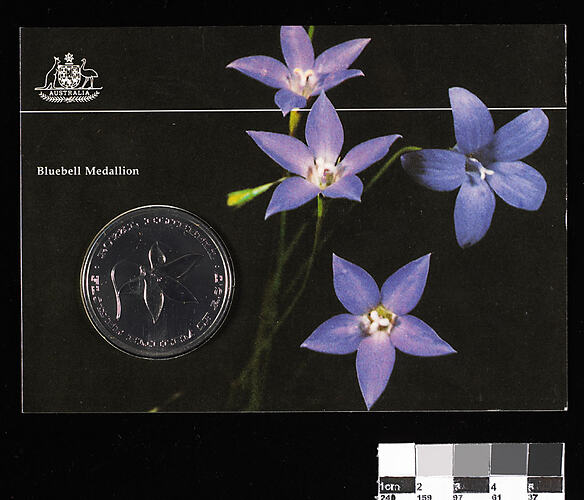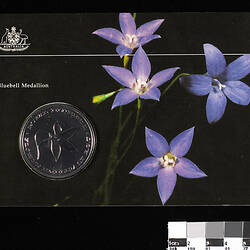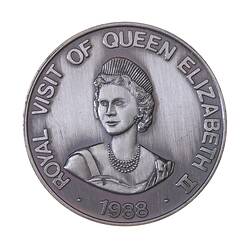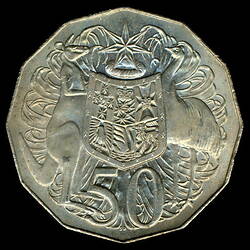Summary
Bluebell Medallion in card pack, circa 1983.
Mint: Royal Australian.
On 26 May 1982 it was announced that the floral emblem for the ACT would be the Royal bluebell Wahlenbergia gloriosa. The bluebell was named in honor of G.G. Wahlenberg (1780-1851), a professor of botany from Sweden. It is native to the high montane areas of the ACT, south-eastern NSW and eastern Victoria. The bluebell medallion was first issued by the Australian Royal Australian Mint in 1983, one of a number of medals for sale to collectors and tourists. The engraving section of the Mint was responsible for both the obverse and reverse design. 1,000 of the medals were made initially, packaged in brown plastic boxes for counter sales. They cost $11.00 each. In 1984 a further 2,000 of the bluebell medals were struck. They were sealed in a blister pack, and were sold for $7.50 each. The medals were cupro-nickel alloy (75% copper, 25% nickel), weighed 24.5 grams, were 40mm diameter and 2.65mm thick.
Obverse Description
Silver medal set in black card with white printed text and coat of arms decorated with bluebell fowers.
Reverse Description
Silver medal set in white card with printed text and bluebell flower.
Significance
On 26 May 1982 it was announced that the floral emblem for the ACT would be the Royal bluebell Wahlenbergia gloriosa. The bluebell was named in honor of G.G. Wahlenberg (1780-1851), a professor of botany from Sweden. It is native to the high montane areas of the ACT, south-eastern NSW and eastern Victoria. The bluebell medallion was first issued by the Australian Royal Australian Mint in 1983, one of a number of medals for sale to collectors and tourists. The engraving section of the Mint was responsible for both the obverse and reverse design. 1,000 of the medals were made initially, packaged in brown plastic boxes for counter sales. They cost $11.00 each. In 1984 a further 2,000 of the bluebell medals were struck. They were sealed in a blister pack, and were sold for $7.50 each. The medals were cupro-nickel alloy (75% copper, 25% nickel), weighed 24.5 grams, were 40mm diameter and 2.65mm thick. -J.B. Joslin, Controller of the Royal Australian Mint, in Australian Coin Review, vol.22, no.6, Dec 1985, pp.37-8. -D. Tout-Smith 17/11/2003.
More Information
-
Collecting Areas
-
Acquisition Information
Donation from Royal Australian Mint, 1996
-
Date Issued
circa 1983 AD
-
Issued By
-
Mint
-
Inscriptions
(edge) (obverse) (reverse)
-
Series
-
Classification
-
Category
-
Discipline
-
Type of item
-
Shape
Rectangle
-
Keywords




